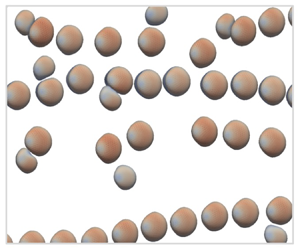Published online by Cambridge University Press: 12 January 2024

Three-dimensional simulations of the ordering of elastic capsule suspensions within planar Poiseuille flow channels are reported. The simulations utilize the immersed boundary method coupled with the lattice Boltzmann method to capture the complex flow-induced capsule deformations and hydrodynamic interactions within the suspensions. A parametric study is presented whereby the confinement ratio and the particle deformability are varied independently within a two-dimensional range relevant to this ordering phenomenon. The initial distribution of capsules is random, and the simulations evolve the system from a disordered state to an ordered one, while an order parameter that quantifies the fraction of capsules belonging to one-dimensional train assemblies is computed throughout time. A monotonic increase in ordering is observed with increasing deformability. However, an optimal confinement ratio is identified corresponding to a peak in the order parameter. This peak is attributed to the competition between increasing long-range capsule attractions and decreasing in-plane capsule density (with fixed volume fraction) as the confinement ratio increases. Simulations are also performed to understand how dispersity in capsule size and deformability impact the degree of ordering. It is shown that ordering is quite sensitive to dispersity in capsule size, and much less sensitive to dispersity in deformability. Overall, the results provide important insights for the design of microfluidic devices.